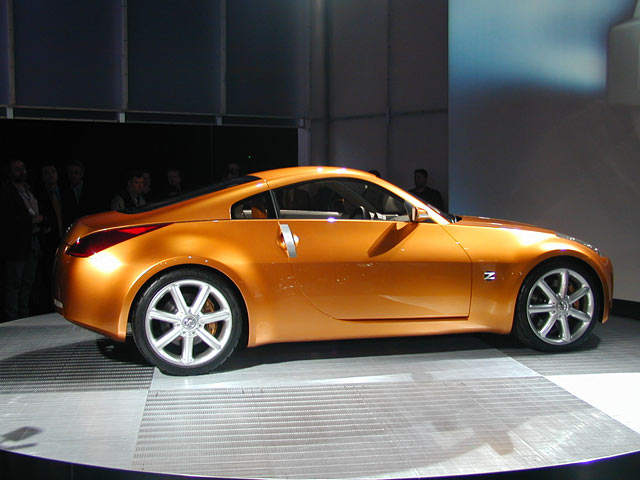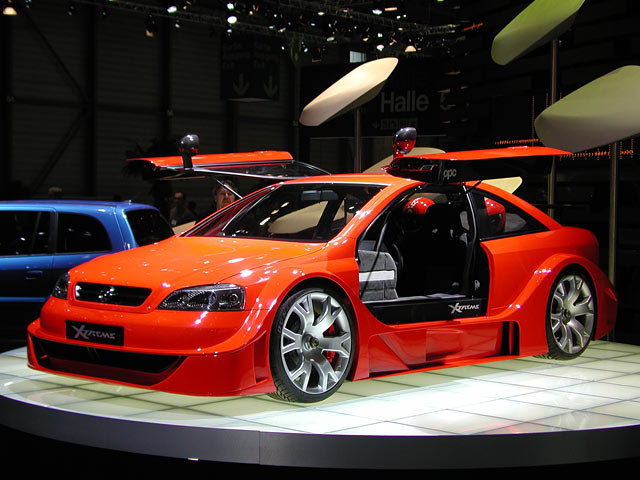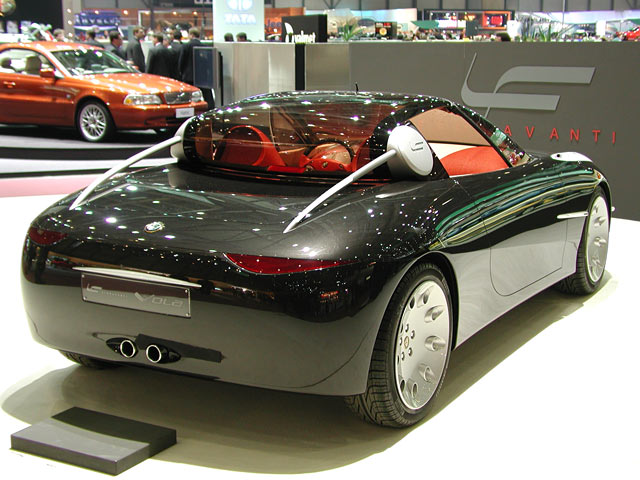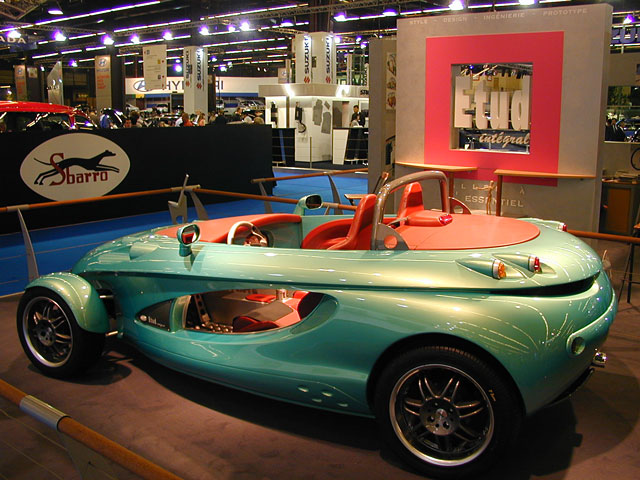|
|
|
|
This is a good place to have images, pictures, thumbnails etc... Place a brief summary of the page of images here? |
|
 |
NISSAN Z-CONCEPT Z-concept Nissan today revealed a new, near-production ready Z sports car, just two years after the first Z Concept vehicle was rushed onto the North American auto show circuit as an initial styling and feasibility study. The new Nissan Z, which is scheduled to go on sale in the United States and Canada in mid-2002 as a 2003 model, is designed to be as revolutionary as the original Datsun 240Z was when it was introduced more than 30 years earlier. “The new Z promises to deliver the performance and high design qualities of today’s cutting-edge sports cars at a truly affordable price,” said Carlos Ghosn, president, Nissan Motor Co., Ltd. (NML). “Our overriding goal has been to build a memorable, no-compromise sports car while keeping the target price under ,000. This new Z meets all of our expectations. It is, quite simply, a stunning achievement.” Public, media and Nissan dealer reaction to the 1999 Z Concept styling exercise was overwhelming - helping accelerate the return of an affordable Nissan 2-seater to the North American market. But unlike the previous Z Concept, which had strong visual links to the original 1970 240Z, the new Z Concept is the company’s latest expression of a contemporary sports car. “The design represents the Z brought into the 21st Century,” said Shiro Nakamura, design director, NML. “Our desire was to honor its ‘Z-ness,’ which is something no other company has, yet not be retro.” In setting the concept for the production Z, the creative team of designers and engineers were guided by what became known as “Z DNA” – the combination of passion, performance, practicality and value that has marked every generation of Z car since the original. For the new Z, this meant developing a perfect combination of performance and handling, value, design and durability. “To be successful in the marketplace, we know that the Z must inspire both appeal and appreciation,” said Nakamura. “First, the design must offer strong visual and driving appeal. But, the Z must also be appreciated for the more practical side that comes with everyday ownership – durability, utility, comfort, reliability and low maintenance.” Other “must haves” for the new Z were also taken from the first generation 240Z – a front engine/rear-wheel drive drivetrain configuration, two-seat interior, a powerful 6-cylinder engine and, of course, a simple and honest design. The new Z, like the original, features a true hatchback body. “The Z is a car that everyone in the entire Nissan organization wanted to work on and contribute to because of what the Z has meant to Nissan over the years,” said Mr. Ghosn. “By staying true to the Z’s rich heritage while looking strictly forward, I believe we’ve created a car that is emblematic of the new face of Nissan.” The design of the new Z was truly an international effort, with contributions from Nissan design studios in Japan and the U.S. from a concept developed at Nissan Design America (NDA), La Jolla, Calif. As fitting of its sports performance essence, the Z design is anchored by very aggressive wheel forms pushed all the way out to the corners. |
| This is one of my favorite images “A long wheelbase and wide stance provided a great starting place,” said Diane Allen, chief designer, Red Studio, NDA. “Our first thought was to recreate the sensation of an open-wheeled Formula 1 car – all wheels and an intimate center structure.” The new Z body is put together much like an airplane fuselage – front compartment, center cockpit and rear compartment. The top line is extremely arched in both side view and plan, with its super-profound sweep creating a dynamic spine with an ever-dynamic, ever-changing view. The Z’s beltline provides a distinctive spine, which crosses over the form in the rear and is anchored in the Z’s strongly visual taillights. “We wanted the design to be an expression of agility – very three-dimensional and moving,” said Mamoru Aoki, Product Chief Designer, Nissan Technical Center (NTC). “The Z is very fluid and relaxed, from the curve of the door cut to the freeness and movement of the glass. It looks fast, but not just in a straight line. It’s a simple yet exacting design, which gives the Z a polished feeling like you get from classic cars.” While retaining elements of both the first 240Z, such as the headlamp treatment, and the last generation 300ZX, the new Z also reflects a very modern, “high design quality” appearance. “We had to find our own statement, which required a different way of putting the Z together – with a high tech, mechanical crispness balancing the more fluid shapes and sections,” continued Allen. “We’ve played up the contrasts with the ‘negative’ center section running through the positive wheel sections. The Z is not all positive and fat – it has a play between elements so you should never get bored with it.” The Z’s cockpit clearly establishes the car as an intimate two-seater with a small greenhouse and a squared-off rear window treatment reminiscent of the 240Z. “The cabin is purposely selfish so there is no mistaking the new Z for a sports coupe or a sports touring car,” said Aoki. “We even avoided the use of a longer door because we didn’t want to suggest that there’s access to a rear seat.” Inside the dramatic Z exterior is a natural, driver-oriented environment with touches of both newness and classic sports car design. The show version is a medley of metal and leather, with unique textures and colors. The front seats incorporate a mesh material, which is not only contemporary-looking but also absorbs sweat. The top half of the front seatbacks also fold forward for easy access to the rear storage compartment featuring dual opening lids. The instrument panel features three gauge pods, similar in design to the 240Z, as well as modern touches such as a navigation system with video display. The door vents and center console have a solid, chiseled-from-a-block-of-aluminum look. The hatchback design is accentuated by functional storage space and an integrated aluminum rear suspension strut tower brace. The brace is finished to match the rest of the rear compartment and carries a Z logo, which is visible from outside the vehicle. “We want to emphasize the practical, performance nature of the strut brace by making it visible from the exterior – like looking at jewelry through a display case. The essence of the Z is performance and we want the design, inside and out, to reinforce that impression,” said Allen. |
 |
 |
The Great Southwest Opel Astra Coupe OPC Xtreme The road-going two-seater is based on the Astra Coupé V8 racing car that has been successfully competing in the German Touring Car Masters (DTM). With its 4.0-liter V8 engine, rear-wheel drive and a sequential, six-speed transaxle gearbox, the engineers at OPC (Opel Performance Center) have carried over the thoroughbred racing technology of the DTM car for the concept vehicle. The powerplant provides the stunning red concept car with 326 kW/440 hp and maximum torque of 930 Nm, taking it to a top speed of over 300 km/h. Among the most eye-catching features of the Astra Coupé OPC X-Treme are its gull-wing doors which, supported by gas-filled struts, swing gently upwards. The imposing wheelarch extensions and profusion of vents and air ducts, all designed with the priority on aerodynamic efficiency, give the Xtreme a very purposeful character. The powerful coupé rolls on specially developed 20-inch tires (265/30 ZR 20 at the front and 305/25 / R 20 at the rear). Based on the same engineering as the DTM car, the study not only proves its suitability for the road, it also demonstrates the synergies that are possible between motor racing and series production. "With this super sports car concept, Opel is underlining its engineering expertise and, at the same time, displaying its commitment to motor sports", says OPC racing manager, Volker Strycek. The OPC X-TREME was named "Most Fun" car of the Motor Show in Geneva by Autoweek magazine. The award was presented to Opel's Director of Design, Hans Seer, by AutoWeek chief editor Dutch Mandel. AutoWeek praised the Opel concept as a car designed "to capture the imagination of those passionate about things automotive." |
|
CHRYSLER CROSSFIRE I love the Southwest. You won't find better scenery anywhere! |
 |
 |
The Great Southwest Fioravanti Vola The Fioravanti Vola presents a possible future Alfa Romeo Spider, with an innovative and very simple folding roof solution. “So far the option of conveniently removing and storing the hard top has seen very interesting but also complex solutions”, says Leonardo Fioravanti. While most roof mechanisms power the roof down into the trunk, the roof of the Vola is simply rotated to rest on top of the decklid, in a concave surface. This solution reduces weight, and allows for more luggage space. The roof, supported by a carbon fiber frame, is made of variable transparent plastic to allow for protection from the sun and rear visibility. To highlight the rotating function Fioravanti has used a very graphic design, with two large discs covering the hinge mechanism. Metal bars extend back along the rear deck, to give a speedy profile, and to conceal the roof when folded back. The front of the Vola presents an evolution and variation on the Alfa Romeo face. The grille is cradled within a strongly defined hood form. The thin fog lamps extend to the sides to become indicator and emergency lights. Main lamp functions are integrated in an extremely long element, which is also used for engine ventilation and to house the rear-view cameras. The interior features an unusual woven material over symmetrical 'canoe' forms which a very laid-back instrument binnacle, featuring new lighting technology and rear view camera displays. The steering wheel is in carbon fiber and leather, with F1 style gearshifts. |
|
ETUD INTEGRAL I love the Southwest. You won't find better scenery anywhere! |
 |
 |
The Great Southwest Another picture from Southern Utah and Colorado |